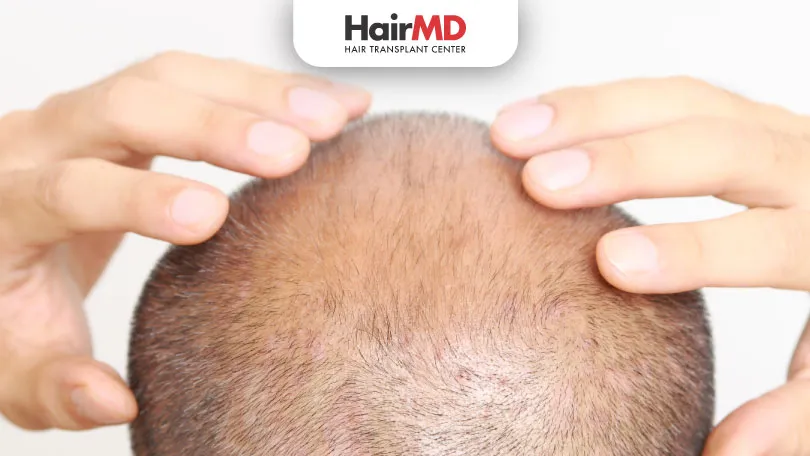18th September, 2021

After a hair transplant, many patients experience hair shedding, which could be either normal or caused by shock loss.
This blog explains the difference between natural post-surgical hair shedding and shock loss, a temporary condition that occurs due to trauma to the scalp during surgery. While shock loss is often temporary, some cases can lead to permanent hair loss. Understanding these distinctions helps in managing expectations and ensuring the best care for your new hair.
What’s covered in the article?
- Hair fall after hair transplant
- What is shock loss after a hair transplant?
- Shock loss after transplant
- When does hair transplant shock happen?
- Hair fall after transplant
- Two types of Shock Loss After Hair Transplant
- What is Telogen Effluvium?
- Can you prevent hair loss after a hair transplant?
- Conclusion
Hair fall after hair transplant
Not many people anticipate baldness or hair thinning, but nowadays medical science has evolved to the point where hair transplant solutions have become next to indistinguishable to your natural hairline and affordable. This means that the grief of losing your hair is no longer permanent.
Hence, hair transplant surgery is becoming extremely popular among men and women, of all age groups. Many people have some misconceptions, related to Hair Transplant. Thinking they might lose transplanted hair after a hair transplant surgery is one of the misconceptions. Temporary hair shedding after Hair transplant surgery is known as Shock loss after hair transplant.
Though in most cases the hair grows back after a short time. It can be stressful to see hair loss after a transplant. In this guide we explain the process of recovery after a transplant and what you can expect.
What is hair shedding?
Hair Shedding after Hair Transplant is a universal characteristic that occurs after hair transplants. It occurs when hair and grafts are harvested. It is stored in the holding solution maintaining temperature and then inserted in the recipient area. These implanted grafts shed from the head which is temporary. These hairs grow back again in two weeks until six weeks of hair transplant.
What is shock loss after a hair transplant?
Shock loss after transplant
Shock loss is a temporary stage of Hair Shedding after Hair Transplant surgery, and it is considered a temporary condition. It is the result of trauma to the scalp which takes place due to certain reasons. Most of the time, it is temporary and regrowth of hairs is seen after a certain time. Shock loss can occur during any kind of hair transplant technique. After every hair transplant surgery is performed, hair surrounding the recipient area may face trauma, and as a result of which they fall out.
During FUE (Follicular Unit Extraction), hair is removed from the donor area using pneumatic pressure. A FUT(Follicular Unit Transplant) using the strip technique is less likely to cause shock loss in the donor area. But, if the surgeon tries to harvest a large number of grafts during a single session and then doesn’t close the strip correctly, permanent hair loss can occur in the area. In the case of the recipient, stress on the miniaturized hair during transplant triggers the loss of hair that was healthy before transplant.
When does hair transplant shock happen?
It is important to inquire whether one’s diet is deficient in any specific nutrients (for example, vegans and the possibility of low vitamin B12 levels) or whether low body weight is causing impaired hair growth.
Hair fall after transplant
Natural hair fall and receding hairlines occur due to hereditary or environmental reasons. Also, if your body produces too much DHT, it can cause your hair to fall out prematurely. It also depends on your internal hormones like androgens. Hair fall after hair transplant also known as hair transplant shock usually happens after or during a procedure. It can happen due to the following reasons:
- Your body’s natural tendency towards hair loss
- The surrounding hair can go into shock during or after the procedure, and it can fall out. However, this condition is temporary.
- If you get the procedure done by an inexperienced surgeon then there are chances that they can damage the surrounding hair follicles.
If your hair is in the telogen effluvium phase, or its shedding phase, during the process then you may experience hair shedding after transplant. It may seem that the hair is not going to grow back, but the shedding is temporary and new hair will grow back.
The shock loss after a hair transplant usually happens in the recipient’s area more than the donor area. Although, there are instances where hair loss can affect both areas. Once the transplanted hair falls out after 10 days, you will notice new hair growth shortly after the shock period is over. The time for new hair growth depends on varying hair textures and thickness levels. Some patients experience slower regeneration than others.
Two types of Shock Loss After Hair Transplant
Temporary shock loss
Temporary Shock loss is a result of trauma to the scalp and it occurs due to many reasons The main characteristic of temporary shock loss is that the hair regrows after a certain period of time, regardless of any causation. It’s important to know, during Hair Transplant, once the graft is put into the recipient’s scalp. It can also harm the surrounding inhabitants. Due to which it can cause them to fall out. But the hair will grow back in time again.
Permanent shock loss
Permanent Shock Loss is the result of a sustained trauma to the hair follicle that does not help to properly regrow hair. Typically, these hairs are already being affected by dihydrotestosterone (DHT), which is the responsible hormone for causing hair loss and baldness, and which will be permanently lost within a number of years. Permanent Shock Loss basically occurs when the hair has been harmed during the process of transplantation.
What is Telogen Effluvium?
Telogen effluvium is different from a shock loss in numerous ways. A few of which is the loss in telogen is transient while the shock loss varies from temporary to transient. Most hair loss from medications is a type of Telogen Effluvium and its causes include retinoids, beta-blockers, calcium channel blockers, antidepressants.
Can you prevent hair loss after a hair transplant?
There are no set solutions that can prevent hair shock loss after or during a transplant. But, there are few preventative techniques that you can implement to reduce the amount of hair loss.
Medication: Some surgeons may prescribe medications like minoxidil or rogaine to reduce the amount of hair fall, which happens during/after hair restoration surgery. Your doctor may also prescribe Finasteride, during the recovery process, to minimize hair shock and fallout.
Improving the graft density:
When the scalp is stressed or feels overwhelmed, the hair follicles enter the resting phase to calm themselves. However, grafts falling out after a hair transplant is not entirely preventable. If your surgeon maximizes the number of grafts without damaging the surrounding follicles, then the chances of shock hair fall can be reduced.
Minimizing transection risk:
Transection happens when the internal structures of the hair follicles are severely damaged during the transplant procedure, to a point they can’t be restored. This is dangerous because it can result in permanent shock hair loss. Even though this case is quite rare, the best way to prevent this is by looking for a qualified and experienced surgeon.
Do You Know?
Nearly 250 Patients Visit HairMD
Everyday For Various Hair Concerns?
(Your journey to healthier and fuller hair starts here!)
Meet Our Dermatologists
Conclusion
In conclusion, it’s important to understand the difference between normal shedding and shock loss after a hair transplant. While shedding is a natural part of the hair growth cycle, shock loss occurs when hair temporarily falls out due to the stress of surgery. In most cases, shock loss is temporary, and hair regrows after a few months. Proper post-transplant care and patience are key to achieving optimal results.
Further Reading
Oily Scalp After Hair Transplant and How to Manage It
Oily scalp after hair transplant is common and manageable. Get simple care tips to reduce oiliness and support a smooth recovery.
Hair Transplant Myths & Facts
Uncover the truth behind common myths about hair transplants. Learn the facts about the procedure, recovery, results, and who makes an ideal candidate for a successful transplant.
How to remove scabs after Hair Transplant? | HairMD
The correct way to remove scabs after hair transplant without damaging grafts. Get expert-backed tips from HairMD Pune to support a smooth recovery.
Shedding Phase After Hair Transplant
Discover essential medications post-hair transplant like finasteride and minoxidil. Learn tips for care and recovery from HairMD Pune experts.
Have thoughts? Please let us know
We are committed not only to treating you, but also educating you.










